Your Complete Guide to Making Bone Broth
Easy recipes for gelatinous bone broth, the benefits of bone broth, how to use it, and all of your questions answered!
I love sharing videos of my nourishing jiggly bone broth and I get questions every day about how I make it and what I use it for. So today we are diving into the world of bone broth—a time-honored, nutrient-packed liquid that you may have heard about already because it has really taken the health and wellness space by storm. Whether you’ve been sipping it daily or are just curious about what makes it so special, I’ve got you covered with everything you need to know. Let’s explore the differences between bone broth and stock, the powerful benefits of both, and a couple of nourishing recipes to try at home.
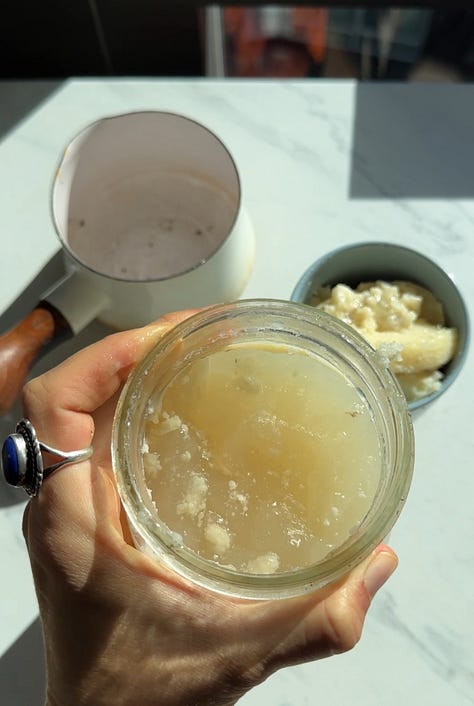
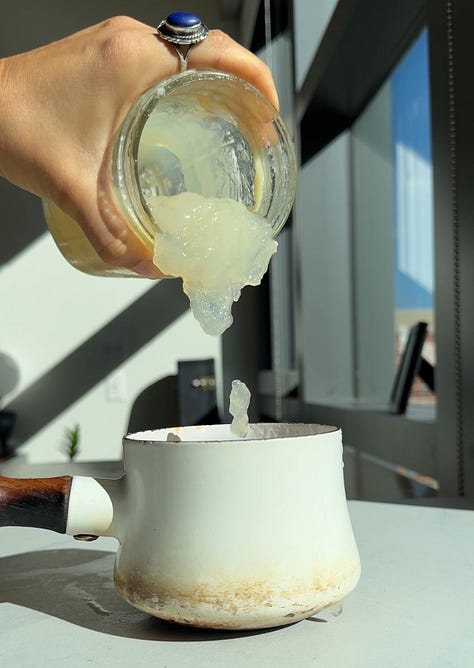
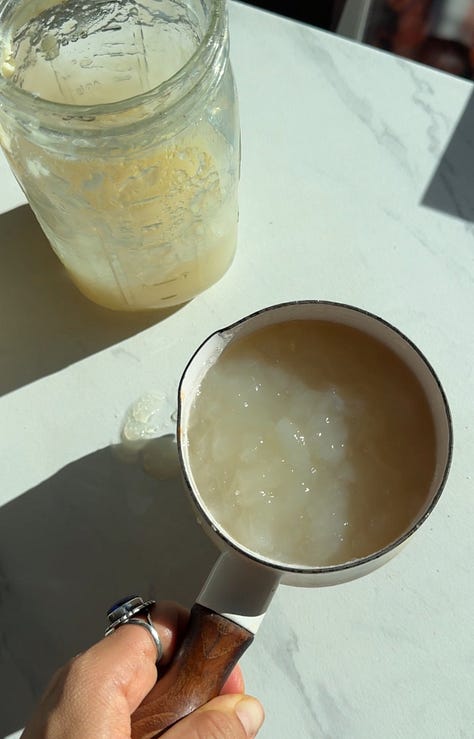
Bone Broth vs. Stock: What’s the Difference?
Bone broth and stock are often confused, but they do have some differences in preparation and nutritional content.
Broth: Made by simmering bones (typically with some meat still attached) for an extended period. You will usually hear people say somewhere from 12 to 48 hours, but I actually don’t think thats necessary - you can read more about that in the Q&A section! The cooking process draws out the nutrients from the bones, particularly collagen, gelatin, and minerals. The result is a deeply flavorful, nutrient-dense broth that's known for its restorative properties.
Stock: Stock is made by simmering bones (sometimes with the addition of aromatics, like carrots, celery, onion, herbs), but usually for a shorter time. It's often used as a base for soups and sauces. While stock provides flavor, it doesn’t contain as many of the beneficial compounds found in bone broth because the simmering time is shorter.
If you want an easy rule of thumb: stock is generally seen as better for cooking and broth is better for sipping.
Personally, the distinction doesn’t make much of a difference to me because I am making most of my stocks/broths and soup bases at home. If I do purchase some at the store I typically just reach for a bone broth option, whether I am sipping on it or using it for a recipe. It just tastes so much more flavorful and packs those amazing nutritious benefits that I am looking to include in my meals.
If you’re wondering what meat stock is, check out the recipes below and the Q&A section!
The Benefits of Bone Broth & How I Use It
Rich in Collagen and Gelatin: Bone broth is abundant in collagen and gelatin, which support joint, skin, and gut health. Collagen, in particular, is a protein that helps strengthen bones and improve skin elasticity.
Supports Gut Health: The gelatin found in bone broth helps to soothe and repair the lining of the digestive tract, making it beneficial for those with digestive issues or conditions like leaky gut.
Source of Minerals: While bone broth does contain some minerals, research suggests that it may not be as mineral-rich as often claimed. Minerals like calcium, magnesium, and phosphorus are present in bones, but they don’t dissolve into the broth in significant amounts, even with prolonged cooking. The small amounts of minerals present in bone broth can still contribute to overall nutrient intake but shouldn't be relied upon as a primary source of minerals like calcium.
Boosts the Immune System: Amino acids like glutamine and proline support immune function and reduce inflammation.
Protein-Packed: Both meat stock and bone broth provide a good amount of protein, with meat stock containing slightly more due to the additional meat used in its preparation.
How to Add it to Your Diet
Sip on a mug. Prep a batch of broth or meat stock and sip on a mug of warm bone broth with lemon juice and sea salt in the morning to support a healthy gut lining.
Use it as a base for soup. A delicious and nourishing soup starts with a quality broth, so use your bone broth to make any soup or stew.
Eat meat stock for breakfast. Prepping a big batch of meat stock is super simple and makes a really easy and delicious protein rich breakfast.
Use it to cook grains or legumes. I love to use broth to cook rice or beans to infuse them with more flavor and nutrients!
Bone broth hot chocolate. Honestly I like to keep my sweet and savory drinks separate lol. But if you have a mild, unseasoned chicken broth, try mixing it with some milk as the base for a hot cocoa.
Use it to cook veggies. I love to cook leafy greens like kale or chard with a bit of broth for more flavor & nutrients.
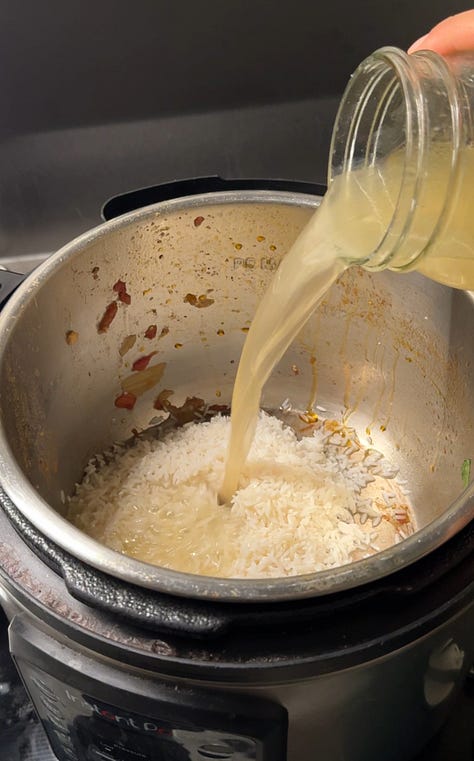
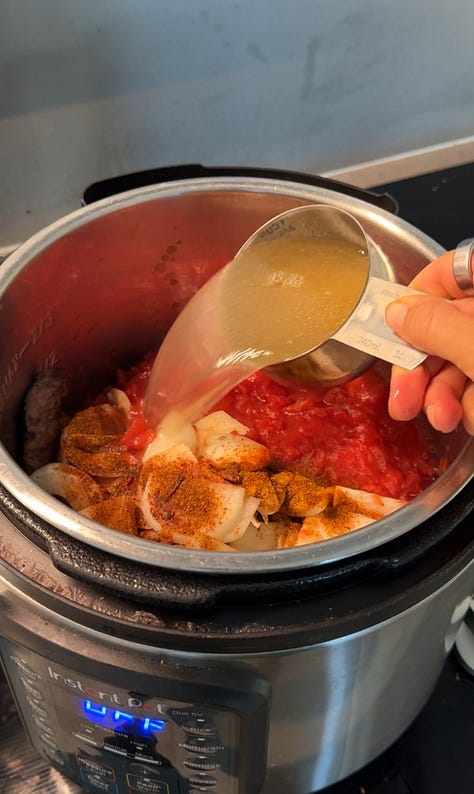
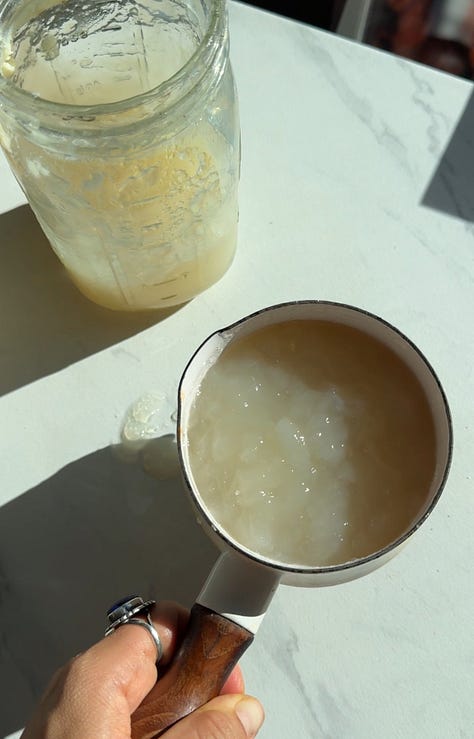
My Go-To Recipes!
Here are are favorite ways to make gelatin-rich broth. This is how I make it - there are many different ways to make it and there is really no right or wrong approach, but I hope these tips help you make your own at home and achieve the jiggly gelatin packed broth we all love!
For reference, I use an 8 qt stainless steel pot for my stovetop bone broth and for cooking a whole chicken soup.
Stove Top Bone Broth
Ingredients:
2-4 lbs beef and/or chicken bones (see Q&A section for the types of bones I prefer)
1 tbsp apple cider vinegar (helps draw minerals out of the bones)
Veggies & aromatics, optional (carrots, celery stalks, onion, garlic, bay leaves, peppercorns)
1 tbsp sea salt, plus more to taste
Filtered water to cover
Instructions:
OPTIONAL: Preheat your oven to 400°F (200°C). Spread the bones (and veggies if including) on a baking sheet and roast them for 45-60 minutes to enhance the flavor. I almost never do this step because I am lazy lol
Transfer the bones to a large stockpot. If including, add any vegetables and aromatics you will include and the apple cider vinegar.
Cover with water, making sure the bones are just barely submerged. Add 1 tbsp sea salt in you’d like.
Bring the broth to a simmer over medium heat. Reduce the heat to maintain a rolling simmer, cover with a lid, and cook for 6-8 hours. I like to skim off any foam or impurities during the first hour of cooking. If the water reduces too much, add a bit more.
Strain the broth through a fine-mesh sieve and season with more sea salt if you’d like. Let it cool, then store in the refrigerator for up to 5 days or freeze for later use.
Instant Pot Bone Broth
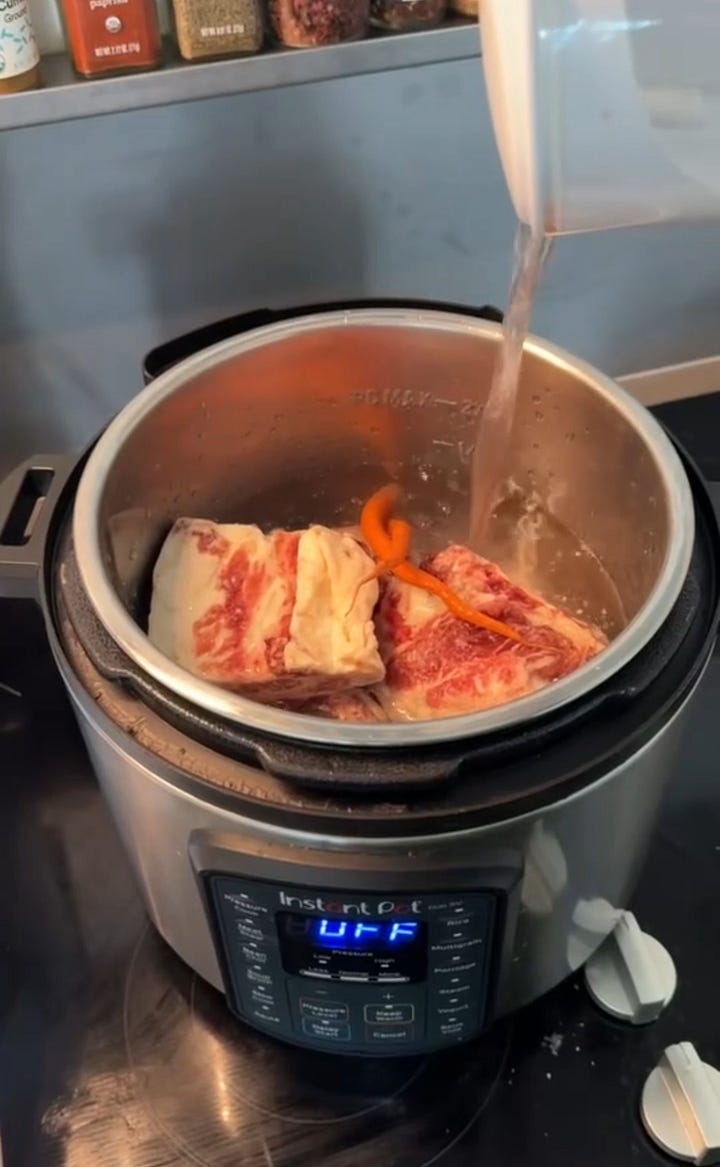

Ingredients:
2-4 lbs beef and/or chicken bones (see Q&A section for the types of bones I prefer)
1 tbsp apple cider vinegar
Veggies & aromatics, optional (carrots, celery stalks, onion, garlic, bay leaves, peppercorns)
1 tbsp sea salt, plus more to taste
Filtered water to cover
Instructions:
OPTIONAL: Preheat your oven to 400°F. Spread the bones (and veggies if including) on a baking sheet and roast them for 45-60 minutes to enhance the flavor.
Place the bones in the Instant Pot and add the apple cider vinegar. Add the veggies & aromatics if including. Fill the Instant Pot with filtered water until the bones and vegetables are just covered (don’t fill past the "max" line).
Close the lid and ensure the valve is set to "Sealing." Set the Instant Pot to High Pressure for 2 1/2 hours.
Once the cooking time is done, allow the Instant Pot to release pressure naturally for about 45-60 minutes before carefully moving the valve to "Venting" to release any remaining pressure.
Strain the broth through a fine-mesh sieve into a large bowl or container. Season with sea salt if you’d like.
Let the broth cool to room temperature. Once cooled, store it in the refrigerator for up to 5 days, or freeze in portions for up to 6 months.
Beef Meat Stock
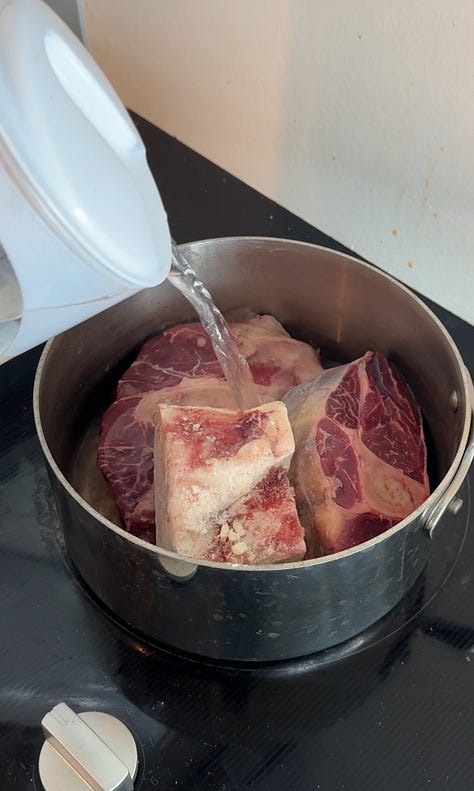
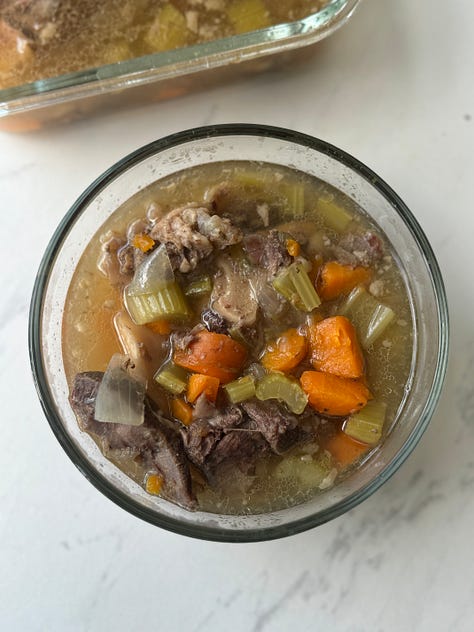
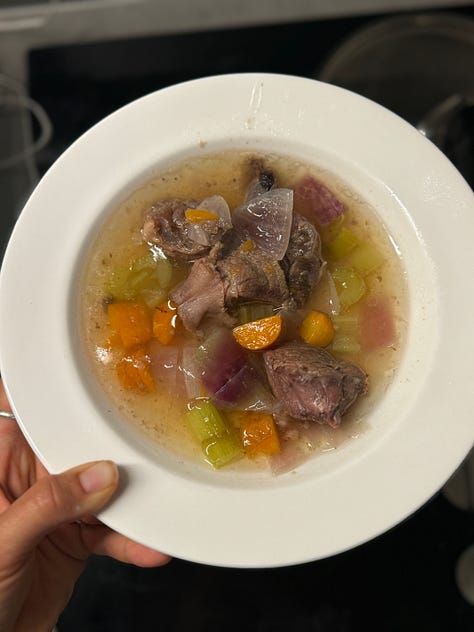
Ingredients:
2-4 lbs oxtail (or other bone-in meat like beef shank/shin or short ribs)
1 tbsp sea salt, plus more to taste
Filtered water
3 carrots, chopped (optional)
1 yellow onion, chopped (optional)
3 ribs celery, chopped (optional)
Directions:
To a large pot, add the meat and sea salt. Add filtered water until the meat is fully submerged. Bring to a boil then reduce to a simmer, cover with a lid, and let simmer for about 2 hours. During the first 30-60 minutes, I like to skim the scum that comes to the top. Add more water if the liquid evaporates.
After 2 hours, add the veggies and cook for another hour. You know it’s ready when the meat is falling off the bone and tender.
Serve and add more sea salt to taste. You can also add herbs and a squeeze of lemon juice.
Chicken Meat Stock
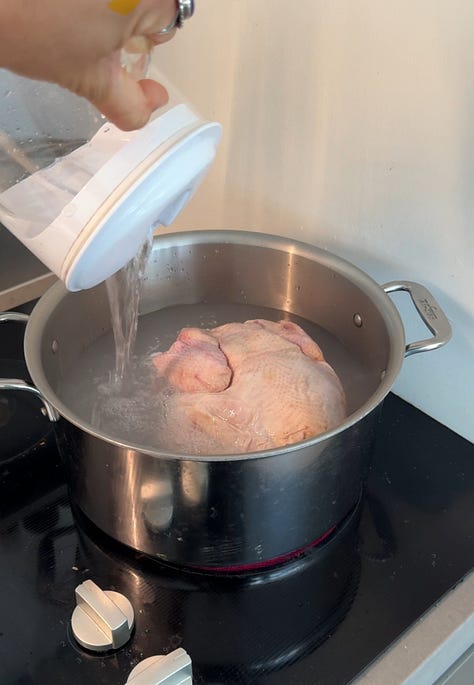
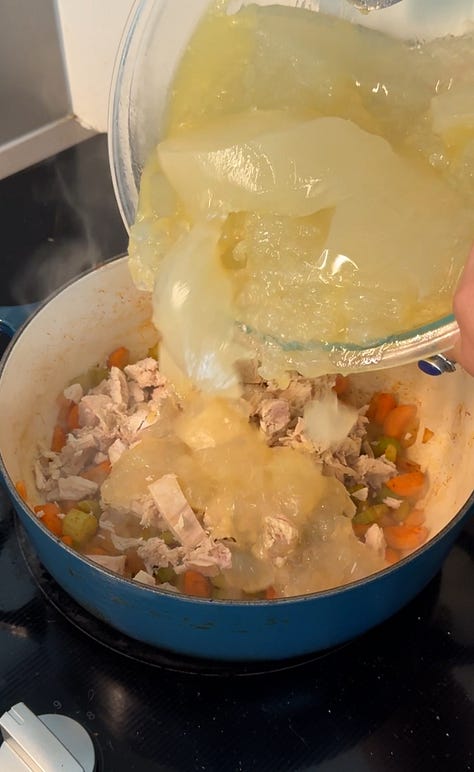

Ingredients:
1 4-5 lb whole chicken, giblets removed
1/2 tbsp sea salt
1 lb chicken feet (optional)
Add the chicken to a large pot. Cover with water and add ½ tbsp sea salt. Bring to a boil then reduce to a simmer and let cook for 60-90 minutes, until the meat is falling off the bone.
Remove the chicken from the pot and set aside until cool enough to handle. Use a fork to separate the meat from the bones.
Return the bones to the pot of water. You can add in chicken feet and other additions you’d like to make a more flavorful broth. Bring to a boil then cover and reduce to a rolling simmer and cook for 4-8 hours. Strain and store the broth and dispose of the bones.
Answering your Questions!
Thanks to everyone who left a question in the Q&A box on Instagram. I answered all of them here:
Are certain bones better than others?
Most collagen is stored in the joint bones, so I opt for beef knuckle bones, neck bones, feet, backs. I actually don’t really use those long marrow bones (save that for roasting and eating the bone marrow - yum!).
My favorite bones: beef knuckle bones, beef neck, beef shank and oxtail, chicken feet, necks & backs, pork trotters.
Thoughts on powdered bone broth?
I find it is more economical and produces a better product to make my own bone broth or shop from a local butcher or farm that makes bone broth so I don’t typically use powdered bone broth. If powdered is the option that works best for you, this is the option I would recommend.
Recommendations for storing/freezing?
I store my broth in the fridge for 5-7 days. To freeze, I like to portion my broth into 1 or 2 cup portions using my Souper Cube molds, then transfer them to an airtight storage container where they will last for about 6 months. These freezing molds are seriously life changing, but you can also freeze in glass jars. Just make sure the broth is cooled to room temp and you leave a good 3 inches of headspace to avoid broken glass jars.
Does boiling time impact quality? How long is too long?
I feel like there is so much confusion around cooking time. Many people think that you need to cook it for 24-48 hours to get all of the nutrients, and it was definitely taken me a few years of perfecting a recipe to figure out that’s not necessarily true. It is all about using heat to extract nutrients from the bones, so if you are cooking on a VERY low temperature, like in a crockpot, it might take a while. I have found that I prefer more of a roiling boil on the stovetop for 8 hours!
How to do it in a crockpot
Follow the recipes included above and add all your bones and desired additional ingredients to a crockpot. Cover with water and let cook for closer to 24 hours, since it is cooking at a lower temperature.
Why is bone broth “better” than meat stock? Meat stock tastes better.
I do not think bone broth is “better” than meat stock. In some cases, meat stock can actually be a much better option! The longer cook times of bone broth may mean that it is slightly higher in nutrients, but that can also make it harder to digest and some people who are in the beginning stages of healing their gut actually do much better with meat stock. In terms of the taste difference, since meat stock uses bones with more meat attached it does have a deeper flavor!
I used chicken feet and it’s still not gelatinous…
While adding chicken feet to your broth is a great way to make your broth more nutrient-rich, simply adding them does not mean you will definitely have jiggly broth. Here are other factors you can trouble shoot:
Add more bones and/or less water. To get a jiggly broth you need a concentrated broth so you may be adding too much water.
Cook the broth longer or at a higher temperature to release the nutrients and get the gelatin-rich giggle.
Just because your broth isn’t jiggly does not mean it is not nutritious, but if you are looking for a concentrated broth that has tons of gelatin and flavor, try out those changes and let me know how it goes.
Gelatinous but still enough quantity for my family.
You will simply need to make a big batch with more bones! Make sure your water is just barely covering the bones, since a water:bone ratio is one of the most common reason people don’t have a gelatinous broth. You can also make a very concentrated broth by cooking the broth until the water reduces a bit and then you can combine that more concentrated broth with water when you consume it or turn it into a soup.
Bone broth and histamine intolerance.
I would recommend the meat stock recipe or experimenting with the pressure cooker recipe! Avoid leftovers, so making smaller amounts at a time would probably be wise.
What ratio of different bones do you use?
I don’t follow any hard and fast rules in terms of the bones I use. Usually I am just using what I have on hand. Here are some of my favorite combos:
Beef knuckle bones
Beef knuckle & chicken frames
Beef shank with some beef knuckle bones
A whole chicken + 1lb chicken feet
Beef knuckle bones and pork trotters
Try different combos and see what you like best!
Thoughts on meat stock versus broth for post surgery or postpartum?
Both are great options! I like meat stock because it is easier to digest, more delicious to eat, and full of protein which we need for recovery!
What are your favorite bone broth brands?
For pre-made bone broth that I can find at my local store I have been liking Bonafide Provisions and Roli Roti Butcher’s Bone Broth. These are both found in the refrigerated/frozen section and actually are gelatinous. I also love Fond bone broth, which I believe you can only order online.
Do you reuse the bones? If so, how many times?
Sometimes if I am making a pressure cooker bone broth I will use the bones 1 additional time or add those bones to another batch of broth using fresh bones. Only reuse bones once and it will result in a less nutrient-packed and less flavorful broth if you do not add additional bones.
What type of bone broth is better for gut healing? How much do I need to drink a day?
For gut healing, try the Beef Meat Stock or Chicken Meat Stock recipe above. Consume as much as you would like in a day, whether that is 1 cup or a couple meals.
Quality of pho broth vs bone broth? Is it the same?
Typically pho broth is made by simmering beef or chicken bones with aromatics and spices, so it has all the delicious flavor and amazing benefits of bone broth! Any other additions like seasoning or sugar will depend on how the specific pho broth is made.
When you pressure can does it lose its properties?
To my knowledge, there may be minor changes in texture and flavor, but it remains a super nutritious option. The main change would be that high heat from pressure canning can break down collagen and gelatin into smaller proteins, so the broth might not gel as much when cooled, but this does not make it any less nutritious!
Thoughts on mixing chicken and beef bones in one pot?
Some people may advise against it since chicken and beef broth may have different shelf lives, but I do it often and have never had a problem.
How can I make bone broth that tastes super yummy like wonton soup broth?
Use bones that have some meat on them, like oxtail or beef shank. Add aromatics to your broth like ginger and garlic and be sure to season with enough salt!
Can I use bones from meats that I have cooked? Like chicken thighs?
Yes, I always have a bag in my freezer where I put produce scraps and leftover bones from meals. I will add these scraps to the pot when I make broths. A chicken thigh bone might not be the ideal bone for broth but I don’t see any harm in saving these leftovers and adding them to other bones to make a broth!
How to incorporate organs without compromising taste?
I do not add organs to my broth and I don’t think I will be doing that in the future. There are plenty of other ways that I enjoy consuming organ meats.
How to get the best flavor? (is it cooking time, ingredients, quality?)
I think I get the best flavor broth when I am cooking with bones that have meat on it. For example, cooking a whole chicken like in the Chicken Meat Stock recipe above. Remember, you can also season bone broth after it is cooked and in individual servings so that it is tasty! I always add a bit of lemon juice, bone broth, and sometimes even some butter to make it tasty. I also like to season broths with garlic and ginger when I am turning them into soups or just for sipping.
How do you find cheap bones?
The best way would be to connect with a local farm and see if you can buy bones in bulk.
How important is organic and high quality? Eg. organic chicken feet & necks?
Since you are extracting the nutrients from collagen rich and fatty parts of the animal, I would opt for the best quality you can access.
What do you do with the fat layer
You can skim the fat off the top after it cools, or leave it for a richer broth. Personally, I like to remove the fat after my broth cools and save it to use as cooking fat. For a pure cooking fat that will last for months, put the cooking fat to a saucepan and let it cook over medium heat. It will bubbly vigorously while the liquid cooks off. Once it stops bubbling you can let it cool and transfer it to a jar with a lid. Store on the counter or in the fridge.
My chicken stock comes out more jelly than my bone broth? Why is that?
It could be that you are using more collagen rich bones, like chicken necks, frames and feet and not using beef joint bones.
Can you use steak or beef roast bones?
I would save those and add them to your broths, like I mentioned above about my scrap bag, but I probably wouldn’t use that as the base for my broth.
Are there any other ways I can get quality gelatin in?
Gelatin is such an important nutrient that so many of us are not getting a lot of, so I am very happy that you all are trying to add more to your diet. If you don’t want to eat bone broth or meats with connective tissue get a quality gelatin powder. I use this one (code OLIVIA).
Final Thoughts
Bone broth is not only a comforting food but also a nutritional powerhouse that supports various aspects of health, from digestion to joint health. I hope these recipes, tips, and Q&A help you make the best broth at home. So go make some broth and report back on how it goes!



